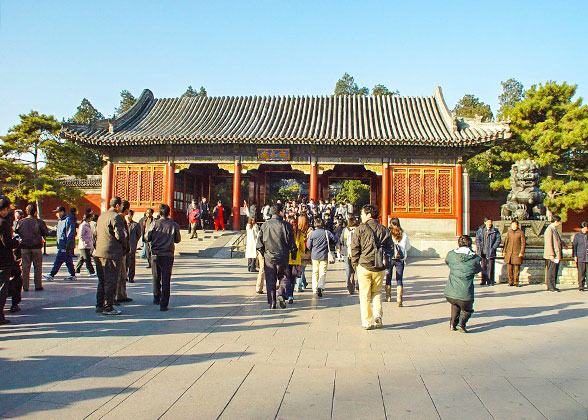East Palace Gate
The East Palace Gate is the front entrance of the Summer Palace. It is an east-facing gateway with gable roof. With two side doors for royal family members and court officials, and three grand doors in the middle exclusively for the Emperor, Empress and queen mother, the East Palace Gate directly represents Chinese culture concerning feudal hierarchy.
The lintels under eaves are patterned with colorful paintings. On the gate hangs a plaque inscribed by Emperor Guangxu with 'Yiheyuan’ (Summer Palace), which literally means to maintain energy and mellow the soul. A Danbi Stairway Stone Carvings leading to the entrance is chiseled with two relief dragons playing with a ball. It was moved from the Yuanmingyuan Ruins (Old Summer Palace) in 1937, symbolizing royal dignity. In front, a couple of bronze lions crouch on white marble pedestals on either side, with male in the south and female in the north.
 |
Regardless the truth of the story, the East Palace Gate makes the Summer Palace more magnificent and grand with this plaque. In addition, about 200 meters (218.7 yards) outside the superb East Palace Gate stands a wooden archway that visitors will see before arriving at the East Palace Gate, named Hanxu and Yanxiu Decorated Archway. 'Hanxu' in the east indicates 'picturesque scenery', and 'Yanxiu' in the west means 'capturing beauty'. Under the saddle roof, brims on either side are deep-carved with dragons and phoenix panels. The archway, as the first structure leading to the entrance, it perfectly points out for visitors the theme of the Summer Palace.
Also, visitors will see a small yard after passing through the East Palace Gate. With nine rooms each side, it was called ‘Neichao House’ or literally ‘House of Inner Court’, in which nine head officers from six ministries of Qing Dynasty were on duty.
![]() Next: Hall of Benevolence and Longevity
Next: Hall of Benevolence and Longevity
![]() Related Link: Summer Palace Travel Tips
Related Link: Summer Palace Travel Tips